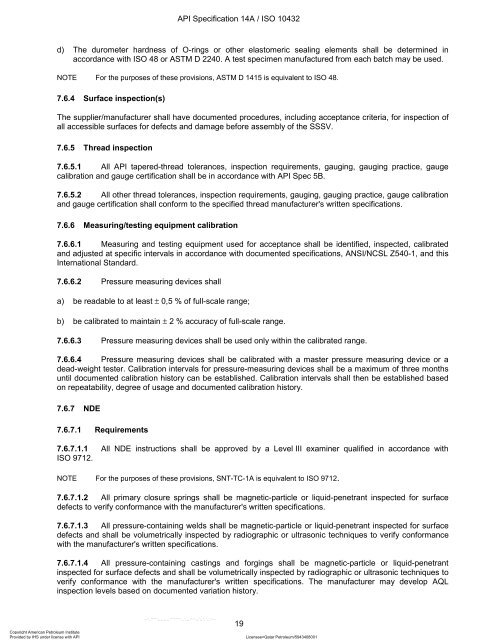- Page 1 and 2:
Knowing Subsurface Safety Valve Equ
- Page 3 and 4:
Charlie Chong/ Fion Zhang Fion Zhan
- Page 5 and 6:
The Magical Subsurface Safety Valve
- Page 7 and 8:
Subsurface Safety Valve (SSSV) Down
- Page 9 and 10:
Well Completion Charlie Chong/ Fion
- Page 11 and 12:
Part 1: Knowing Subsurface Safety V
- Page 13 and 14:
Subsurface Safety Valve (SSSV) Char
- Page 15 and 16:
Subsurface safety systems provide e
- Page 17 and 18:
Hurricane Lili Charlie Chong/ Fion
- Page 19 and 20:
This analysis should consider these
- Page 21 and 22:
The need for a new and more reliabl
- Page 23 and 24:
Charlie Chong/ Fion Zhang
- Page 25 and 26:
The International Organization for
- Page 27 and 28:
Early subsurface safety valves were
- Page 29 and 30:
Typical subsurfacecontrolled safety
- Page 32:
A new type of valve became necessar
- Page 36:
Surface-controlled subsurface safet
- Page 39:
Surface-controlled subsurface safet
- Page 43:
The flapper-valve design, pioneered
- Page 47:
Schlumberger valves are tested to a
- Page 51:
Typical safety-valve self-equalizat
- Page 55:
When the flapper is closed, as show
- Page 58:
SCSSV Charlie Chong/ Fion Zhang htt
- Page 62:
After actuation - After an incident
- Page 66:
Flapper-type safety valves today in
- Page 70:
One such design is shown in the Fig
- Page 74:
Halliburton Subsurface Safety Valve
- Page 78:
Conveyance systems - There are two
- Page 82:
■ Slickline-conveyed, slickline-r
- Page 86: Slick Line retrievable Surface Cont
- Page 90: Charlie Chong/ Fion Zhang https://w
- Page 94: Slickline- Retrievable SCSSV https:
- Page 98: Surface Controlled SSV- Flapper Typ
- Page 102: Weatherford Slickline Retrievable S
- Page 106: A ScaleGard treatment imparts the s
- Page 110: The safety-valve control fluid must
- Page 114: Heavy-wall Flow Couplings Turbulent
- Page 118: Bruce field Charlie Chong/ Fion Zha
- Page 122: Optimizing Flow Safely A systems ap
- Page 126 and 127: TRM-4PE safety-valve assembly used
- Page 129: For higher gas flow-rate conditions
- Page 133: Gas Slam Testing * The specified AP
- Page 139: SINTEF Visit of the Vresova IGCC po
- Page 143: Technical and economic influences d
- Page 147: Interventions are becoming more cos
- Page 151: Safety-valve curved flapper. The cu
- Page 155: Camco introduced a rod-piston actua
- Page 158: Greater depth can also be achieved
- Page 162: Located in the Gulf of Mexico about
- Page 166: Nansen field Charlie Chong/ Fion Zh
- Page 169: Close cooperation between Kerr-McGe
- Page 173: Using this valve series contributes
- Page 177: To date, Kerr-McGee and Schlumberge
- Page 181: The success and reliability of feat
- Page 185: PART 2: • API 14A Charlie Chong/
- Page 188 and 189:
--`,`````,,,,,,,,````````,,`,,,-`-`
- Page 190 and 191:
API Foreword This standard shall be
- Page 192 and 193:
ISO 10432:2004(E) API Specification
- Page 194 and 195:
--`,`````,,,,,,,,````````,,`,,,-`-`
- Page 196 and 197:
ISO 10432:2004(E) API Specification
- Page 198 and 199:
ISO 10432:2004(E) API Specification
- Page 200 and 201:
ISO 10432:2004(E) API Specification
- Page 202 and 203:
ISO 10432:2004(E) API Specification
- Page 204 and 205:
ISO 10432:2004(E) API Specification
- Page 206 and 207:
ISO 10432:2004(E) API Specification
- Page 208 and 209:
ISO 10432:2004(E) API Specification
- Page 210 and 211:
ISO 10432:2004(E) API Specification
- Page 212 and 213:
ISO 10432:2004(E) API Specification
- Page 214 and 215:
ISO 10432:2004(E) API Specification
- Page 216 and 217:
ISO 10432:2004(E) API Specification
- Page 218 and 219:
ISO 10432:2004(E) API Specification
- Page 220 and 221:
ISO 10432:2004(E) API Specification
- Page 222 and 223:
ISO 10432:2004(E) API Specification
- Page 224 and 225:
ISO 10432:2004(E) API Specification
- Page 226 and 227:
ISO 10432:2004(E) API Specification
- Page 228 and 229:
ISO 10432:2004(E) API Specification
- Page 230 and 231:
ISO 10432:2004(E) API Specification
- Page 232 and 233:
ISO 10432:2004(E) API Specification
- Page 234 and 235:
ISO 10432:2004(E) API Specification
- Page 236 and 237:
ISO 10432:2004(E) API Specification
- Page 238 and 239:
ISO 10432:2004(E) API Specification
- Page 240 and 241:
ISO 10432:2004(E) API Specification
- Page 242 and 243:
ISO 10432:2004(E) API Specification
- Page 244 and 245:
ISO 10432:2004(E) API Specification
- Page 246 and 247:
ISO 10432:2004(E) API Specification
- Page 248 and 249:
ISO 10432:2004(E) API Specification
- Page 250 and 251:
ISO 10432:2004(E) API Specification
- Page 252 and 253:
ISO 10432:2004(E) API Specification
- Page 254 and 255:
ISO 10432:2004(E) API Specification
- Page 256 and 257:
ISO 10432:2004(E) API Specification
- Page 258 and 259:
ISO 10432:2004(E) API Specification
- Page 260 and 261:
ISO 10432:2004(E) API Specification
- Page 262 and 263:
ISO 10432:2004(E) API Specification
- Page 264 and 265:
ISO 10432:2004(E) API Specification
- Page 266 and 267:
ISO 10432:2004(E) API Specification
- Page 268 and 269:
ISO 10432:2004(E) API Specification
- Page 270 and 271:
ISO 10432:2004(E) API Specification
- Page 272 and 273:
API Specification 14A / ISO 10432 A
- Page 274 and 275:
--`,`````,,,,,,,,````````,,`,,,-`-`
- Page 276:
PART 3: • Form 175-454400 Charlie
- Page 279 and 280:
INSPECTION & TESTING REQUIREMENTS S
- Page 282:
Charlie Chong/ Fion Fion Zhang Zhan

















